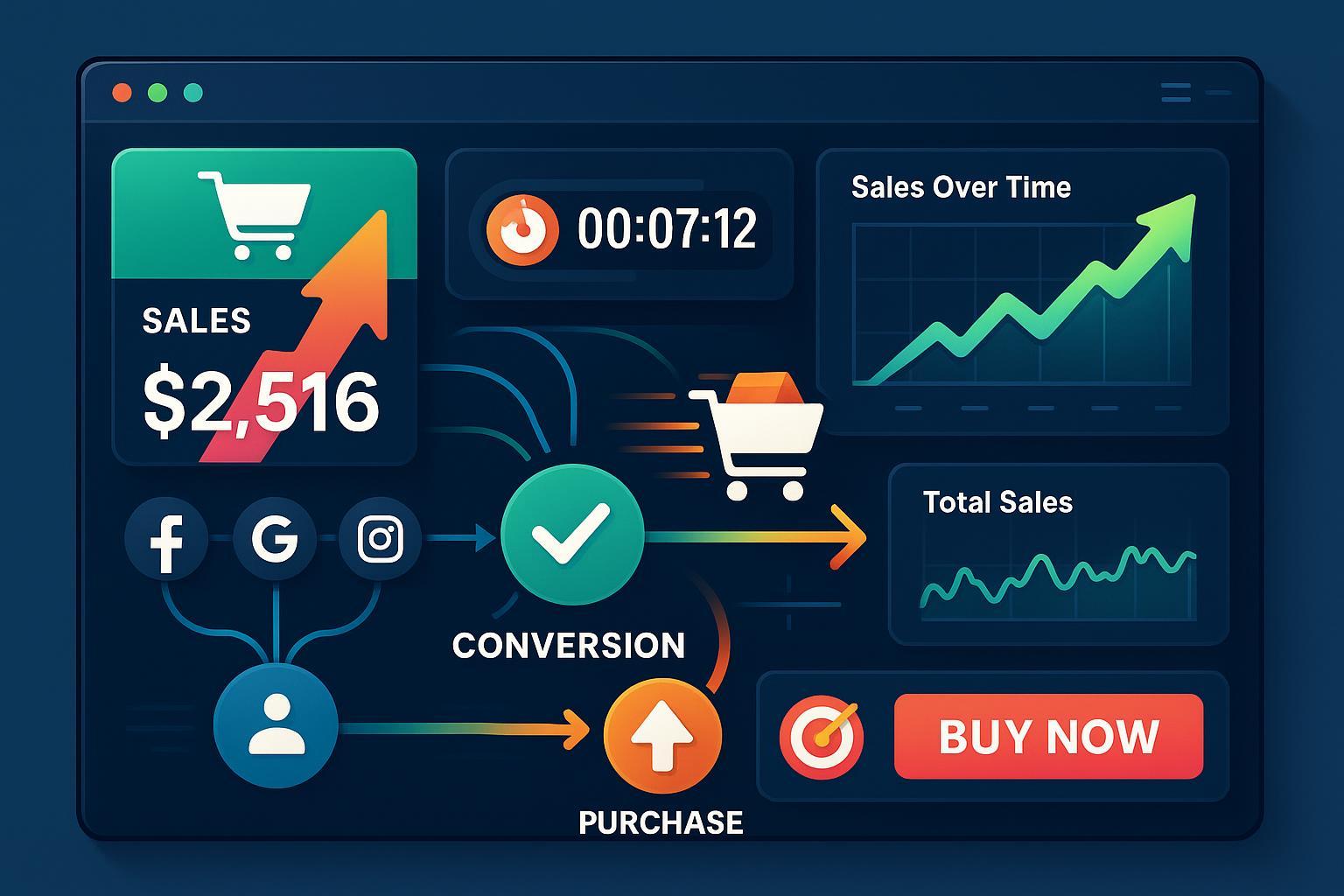Leveraging Low Funnel Marketing to Drive Immediate Sales: Strategies That Work (E-commerce, 2025)

How 2025 Changed the Rules: Why Superior Low Funnel Strategy Matters Now
If you run a Shopify store or any high-volume DTC operation in 2025, you’re living through a confluence of new realities: privacy-first data, AI-powered competition, rising CPAs, and shoppers who expect instant—yet personal—experiences. In my role running performance growth for several e-commerce brands, the old playbooks just don’t cut it anymore. Immediate sales aren’t won through luck or guesswork. They require next-level low funnel (BOFU) strategy that’s orchestration-heavy, data-integrated, measured by channel-accurate attribution, and ruthless about trimming waste.
Here’s my best-practices field guide—stepwise, benchmarked, and mistakes-included—for practitioners ready to win the bottom of the funnel in 2025.
1. Dynamic Retargeting: Engineering the Hardest Hitting Reminders
The 2025 Workflow
- Integrate live product catalogs with Meta, Google, TikTok for dynamic product-level ads.
- Segment by behavior: cart abandoners, recent product viewers, repeat customers, and high-value prospects.
- Automate cross-channel retargeting: Coordinate messages across paid social, display, SMS, and even email.
- Refresh creative and offers at least bi-weekly to defy ad fatigue.
- Monitor in real time using attribution dashboards (see Attribuly walk-through below).
Proof Point: Dynamic retargeting drives conversion rates up to 5x higher than static display (Cropink), with cart abandonment emails/SMS often restoring 10–20% of lost checkouts.
Attribuly in Action:
Attribuly’s server-side tracking and channel-native integration ensure you’re not missing attribution in a cookieless world. Merchant example: After integrating Attribuly’s Meta + Google product feeds and setting up segment-triggered sequences, a niche DTC apparel store raised BOFU conversion from 2.7% to 4.9% within 30 days, tracking every sale’s source.
Pro Tip: Realize that retargeting frequency is a double-edged sword. Too much = unsubscribes. Set frequency caps and automate exclusions for recent converters—Attribuly’s audience segmentation tools make this breezy.
2. Personalized Triggered Workflows: Email, SMS, and Beyond
The BOFU Automation Playbook
- Identify triggers: Cart abandonment, browse/exit intent, price drop, and time-on-site events.
- Layer channels: Start with email, then escalate to SMS/push if no sale after 4–6 hours.
- Use dynamic content blocks: Each message references the exact product and offer the user engaged with, using real-time catalog sync.
- Test incentives: A/B incentives—shipping, bundle offers, or VIP perks—based on segment and purchase history.
- Optimal timing: Test delays (30 mins, 3 hours, 20 hours)—SMS reminders often work best within the first 2 hours post-abandonment (Omnisend).
ROI Anchor: Automated cart flows typically achieve 7–10% conversion rates with SMS outperforming email for immediacy, and $36–$40 return per $1 spent across channels (Databox).
Attribuly Moves
Use Attribuly’s workflow automation to trigger campaigns based on specific Shopify and website events—no-code required. The segmentation engine supports fine targeting by cart content, prior purchase value, and source channel, with all results tied back to real attribution reports.
Watchout: Over-automation feels robotic. Monitor reply rates and churn; blend in live chat or real human follow-up for VIP segments to keep response rates healthy.
3. The Attribution Revolution: Measuring What Matters and Actively Optimizing
Why Attribution is Non-Negotiable in 2025
- Privacy changes and the limits of pixel-based tracking demand server-side setups—client-only tracking leaves up to 20% of BOFU sales unattributed (TagTuners).
- Multi-touch attribution delivers an accurate split: did they convert after TikTok + search + email, or did a single last-minute retarget do the work? Relying on last-click under-values early- and mid-funnel efforts.
How to Execute
- Hybrid tracking: Deploy both Shopify’s native pixel and server-side platforms like Attribuly for redundancy and compliance.
- Automate event deduplication/validation: Ensure all triggered workflows (from Klaviyo, native Shopify, etc.) are feeding data to a single, accurate dashboard.
- Model mix: Use Attribuly’s dashboard to view by linear, time-decay, and algorithmic multi-touch models, letting you see which channels truly spark and close conversions.
Hard Data: Brands moving from siloed/last-click to multi-touch + server-side attribution report cuts in reporting mismatches from ~20% to under 2% (EasyInsights).
Real Use Case:
A direct-to-consumer supplements brand shifted to Attribuly’s hybrid model, fixing significant revenue misattribution and unlocking a +24% increase in Facebook and Google optimized campaign ROAS in under 60 days.
4. AI-Powered Segmentation and Personalization—Instant, Predictive, Precise
2025 Segmentation Playbook
- Feed historic and live data (behavior, LTV, churn risk) into AI tools for hyper-relevant segment definition.
- Automate predictive triggers: High-likelihood buyers get “buy now” urgency messages; churn-prone get targeted loyalty offers.
- Dynamic insertions: Personalized pages/offers appear based on AI’s “next best action” scoring in real-time.
Benchmarks: Brands leveraging machine learning for segmentation in 2025 are seeing conversion lift from 10–25% compared to manual/”static” segment targeting (Dynamic Yield).
Attribuly Edge
Attribuly’s AI analytics assistant mines source, behavior, and previous outcome data to recommend and automate cohort targeting—no developer required. Example: A skincare store deployed real-time LTV scoring to automatically trigger a higher-discount “Winback” offer for high-churn, previously high-value buyers, boosting instant sales by 17% compared to last year’s generic blast.
Pitfall Alert: Over-segmentation and over-automation can backfire—watch for diminishing returns and offer “fatigue.” Balance automated triggers with occasional “handwritten” or humanized campaigns for best-in-class user experience.
5. The Psychology of Conversion: Urgency, Scarcity, and Smart Offer Design
- Deploy countdown timers, limited-quantity messages, and explicit FOMO signals across BOFU surfaces—especially checkout, cart, and product pages.
- Run “expiring” instant-offer campaigns: 24-hour shipping upgrades, flash discounts tied to segment behavior (e.g., “People who viewed this in the last 3 hours…”), and limited stock warnings with real inventory sync.
Example: Meta retargeting ads using “Only X left” copy + dynamic coupon codes delivered 18% higher conversion (case trend via SEMrush).
Be sure your urgency is authentic; fake scarcity erodes trust—and conversion—for good.
6. Landing Page & Checkout Optimization: Maximum Friction Removal
- Single-purpose landing pages for retargeted users with fewer distractions, bulletproof mobile optimization, and sticky “buy now” CTAs.
- Trust badges, payment assurance, live support—non-negotiables for 2025 buyers.
- Instant checkout flows: Shopify’s Shop Pay and one-tap wallet integrations for speed.
Hard Metric: DTC stores that implement dedicated BOFU landing experiences for retargeted/skipping prospects consistently see conversion uplifts of 8–20% over generic product detail pages (ConvertCart).
7. Loyalty & Referral for Instant Repeat Purchases
- Launch post-purchase instant-referral triggers (double-sided reward offers, social-share perks).
- Deploy fast-win loyalty perks at initial checkout for second purchase nudges—free shipping, early access.
- Automate with Shopify + Attribuly: Segment first-time vs. repeat, trigger relevant rewards instantly, and track revenue attributed to loyalty via Attribuly’s dashboards.
8. Troubleshooting and Field Fixes: Common Traps & Prevention Checklist
- Retargeting fatigue: Watch for frequency creep—monitor unsubscribe and bounce rates. Adjust creative, add suppression logic.
- Over-automation: If open rates, clicks, or CVR dip, back off sequence complexity. Return to “human-first” for high-value segments.
- Attribution confusion: Run regular event audits—in Attribuly, cross-check channel-level and server-side logs. Correct misfires immediately.
- Segmentation excess: More isn’t always better—start broad, analyze, then go granular only where incremental ROI can be proven.
9. The Advanced BOFU Framework: Your 2025 Battle Plan
- Orchestrate multi-channel, multi-touch workflows—every BOFU action and trigger must be tracked, segmented, and reported in a unified dashboard (Attribuly makes this reality on Shopify/DTC).
- Balance automation and authenticity for highest impact—and lowest churn risk.
- Lean on AI for predictive targeting, but humanize when scaling fails to deliver incremental lift.
- Benchmarks first: Track every change to a hard KPI, not anecdote.
- Adapt to change: Tech, privacy, ad policy—all will shift. Future-proof your BOFU by centering on data you own, infrastructure you control, and tools backed by active 2025 support.
Conclusion & Next Steps
Winning in the low funnel in 2025 is about orchestrating the right technology, workflow, and psychology—tracked relentlessly and iterated with eyes wide open. Attribuly empowers Shopify brands to execute, measure, and adapt at the frontlines of BOFU marketing, from attribution to real-time campaign optimization.
Ready to drive your next sales surge?
- Explore Attribuly for advanced Shopify attribution, retargeting, and AI-powered campaign insight
- Benchmark your setup using the above frameworks—then iterate, measure, and win.
References:
- SEMrush: Lower-Funnel Marketing Ideas
- Omnisend: SMS Marketing Benchmarks
- ConvertCart: Ecommerce Conversion Benchmarks
- Dynamic Yield: AI Segmentation Case Study
If you want to see more technical workflow diagrams, playbooks, or request a custom BOFU audit, connect or comment below. Growth, in 2025, is a team game—let’s build smarter, together.
